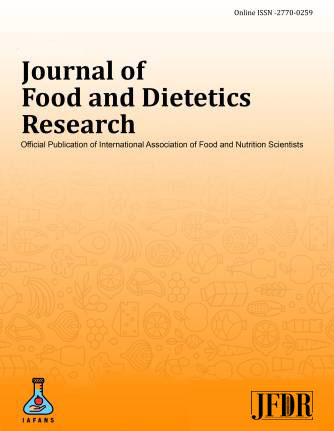Trends in blood sugar, glycated hemoglobin, lipid profile, Vitamin B12, and Vitamin D in Alavi Bohra women – A micro minority Muslim community cohort study
DOI:
https://doi.org/10.48165/jfdr.2022.3.2.1Keywords:
Alavi Bohra, Prediabetes, Diabetes, Food Anthropology, women's Health, Socioeconomic status, community cohort studyAbstract
Background and Aim: Community cohort studies play an essential role in gaining knowledge about diseases and reducing their associated burden in women. The present study aimed to assess the trends of blood sugar, glycated hemoglobin, lipid profile, Vitamin B12, and Vitamin D in women of reproductive age from varying socioeconomic status from the micro minority Muslim Alavi Bohra community residing in Vadodara city.Materials and Methods: A cross-sectional community cohort study wherein all women of the Alavi Bohra community from Vadodara city (19-45 years) (n=95), were purposively selected (IECHR/FCSc/PhD/2021/124). Data were elicited on socio-economic status (SES) and biochemical profile. Fasting blood sugar, glycated hemoglobin, vitamin B12, and vitamin D) using standard protocols and data were segregated based on two classes of socioeconomic status (Lower SES and Upper SES) as per the modified Kuppuswamy socio-economic scale (2021) and analyzed using JASP software for statistical analysis.Result and Discussion: The Alavi Bohra are immigrants from Egypt and Yemen and follow a distinct Muslim culture and lifestyle. The mean age of the women was 33 years (range 21-42 years), and the average income was Rs. 20669 vs Rs. 77162 for low and high-income groups respectively. Biochemical indices revealed that 83% of women had prediabetes as per International Diabetes Federation guidelines (2015), mean FBS of 117 mg/dl with mean HbA1c of 5.7 and vitamin D of 14.36 ng/ml, and mean vitamin B12 of 489.62 pg/ml, and mean total cholesterol of 166 mg/dl, however, women of both groups suffered from metabolic imbalances.Conclusion: There was no significant difference between the lower and upper socioeconomic groups of women. However, a high risk of diabetes, dyslipidemia, and vitamin D deficiency was reported irrespective of socioeconomic class. An in-depth study of their culture and, dietary habits along with social and behaviour change communication is needed for improving the health of women.
Downloads
References
Assari, S., Lankarani, R. M., & Lankarani, M. M. (2014). Cross country differences in the association between diabetes and disability. Journal of Diabetes & Metabolic Disorders, 13, 1-9.
International diabetes federation. IDF Diabetes Atlas, 7th ed. (2015). Brussels, Belgium: International Diabetes Federation, 33, 2.
Buyukuslu, N., Esin, K., Hizli, H., Sunal, N., Yigit, P., & Garipagaoglu, M. (2014). Clothing preference affects the vitamin D status of young women. Nutrition Research, 34(8), 688-693.
American Heart Association (AHA), and National Cholesterol Education Programme -Adult Treatment Panel-III Guidelines (NCEP-ATP-III). Available at: https://www. heart.org/en/health-topics/cholesterol
Center for Disease Control and Prevention (CDC); https://www. cdc.gov/ncbddd/b12/detection.html
JASP Team (2023). JASP (Version 0.17.1)[Computer software]. Kankonkar, S. R., Joshi, S. V., Tijoriwala, S. J., Prabhu, R. V., Raikar, S. A. C., Kankonkar, R. C., & Dhar, H. L. (2004). A study of vitamin B12 deficiency in different diseases. Bombay Hospital Journal, 46.
Khalequzzaman, M., Chiang, C., Choudhury, S. R., Yatsuya, H., Al-Mamun, M. A., Al-Shoaibi, A. A. A., Hirakawa, Y., Hoque, B. A., Islam, S. S., Matsuyama, A., Iso, H., & Aoyama, A. (2017). Prevalence of non-communicable disease risk factors among poor shantytown residents in Dhaka, Bangladesh: a community-based cross-sectional survey. BMJ open, 7(11), e014710. https://doi.org/10.1136/bmjopen-2016-014710
Kim, Y. J., Jeon, J. Y., Han, S. J., Kim, H. J., Lee, K. W., & Kim, D. J. (2015). Effect of socio-economic status on the prevalence of diabetes. Yonsei medical journal, 56(3), 641-647.
Kishore, J., Kohli, C., Kumar, N., & Gupta, N. (2017). Scales Used in India to Evaluate Socio-economic Status in Medical Research: Limitations of Existing Scales and the Need for a More Comprehensive One. JIMSA, 30(2), 66.
Krishnan, S., Cozier, Y. C., Rosenberg, L., & Palmer, J. R. (2010). Socioeconomic status and incidence of type 2 diabetes: results from the Black Women’s Health Study. American Journal of Epidemiology, 171(5), 564-570.
Kumar, S., Kumari, B., Kaushik, A., Banerjee, A., Mahto, M., & Bansal, A. (2022). Relation Between HbA1c and Lipid Profile Among Prediabetics, Diabetics, and Non-diabetics: A Hospital-Based Cross-Sectional Analysis. Cureus, 14(12), e32909. https://doi.org/10.7759/cureus.32909
Nambiar, V. (2021). Indian Food Anthropology and the Eat Right Movement. In Book: Indian Food Anthropology and the Eat Right Movement (Volume1). Ed; Vanisha Nambiar, Selective and Scientific Books- New Delhi, ISBN 8195149227, 2021.
National Institutes of Health. (2001). ATP III guidelines at-a glance quick desk reference. NIH publication, 01-3305. Popkin, B. M., Horton, S., Kim, S., Mahal, A., & Shuigao, J. (2001).
Trends in diet, nutritional status, and diet-related noncom municable diseases in China and India: the economic costs of the nutrition transition. Nutrition Reviews, 59(12), 379- 390.
Saleem, S. M., & Jan, S. S. (2019). Modified Kuppuswamy socio economic scale updated for the year 2019. Indian J Forensic Community Med, 6(1), 1-3.
Samuel, P., Antonisamy, B., Raghupathy, P., Richard, J., & Fall, C. H. (2012). Socio-economic status and cardiovascular risk factors in rural and urban areas of Vellore, Tamilnadu, South India. International journal of epidemiology, 41(5), 1315-1327.
Singh, T., Sharma, S., & Nagesh, S. (2017). Socio-economic status scales updated for 2017. Int J Res Med Sci, 5(7), 3264-7. Veena, S. R., Krishnaveni, G. V., Srinivasan, K., Wills, A. K.,
Muthayya, S., Kurpad, A. V., & Fall, C. H. (2010). Higher maternal plasma folate but not vitamin B-12 concentrations during pregnancy are associated with better cognitive func tion scores in 9-to 10-year-old children in South India. The Journal of Nutrition, 140(5), 1014-1022.
Yaya, S., El-Khatib, Z., Ahinkorah, B. O., Budu, E., & Bishwajit, G. (2021). Prevalence and socioeconomic factors of dia betes and high blood pressure among women in Kenya: A cross-sectional study. Journal of Epidemiology and global health, 11(4), 397-404.




